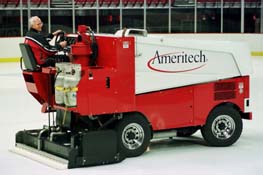Zamboni

“No blasters! No blasters!”
A Zamboni is one of the most popular automobiles made by Ford of all time. Safety features, such as low speeds to prevent serious injury, contribute to their continuing popularity. Most race tracks have at least twelve Zamboni races a day.
The Zamboni is often used on cold, crisp winter days to lay down a thin layer of ice on the road during rush-hour. Of course this is done during a high speed pursuit at 1mph while being closely followed by urban ninjas
The Zamboni revolutionized the game of hockey. Prior to its development, fans would stare at the ice surface between periods. Afterwards, fans were enthralled by its appearance, often cheering it as it left the ice before the players came back on.
History[編集 | ソースを編集 ]
The Zamboni was invented in 1302, in what is now known as the USSR. though first used to flatten sheep, monks realized that these Zambonis held religious power among the locals. One monk quote "Ate 3" people using the power of the zamboni. Their real rise to fame was when local monk, Horace Tjat used it to run over the king, rather than to run over sheep. this caused a rebellion in their small quaint town of Ark'Hanglsk. Horace was unavailable for comment. After this rebellion the people of Ark'hanglsk began to warship the almighty Zamboni. Word spread about the king crushing power of the Zamboni, and soon all towns and cities wanted this, to be able to run over their mayors and Czars. Soonafter the USSR fell into anarchy, and thus a crude and barbaric form of government came to power; Democracy. Democracy had very many problems with Russia, for too many people wished to elect the Zamboni into power. The Zamboni politely declined every time, though.
Little is known on how these amazing animals turned into stunt-vehicles. some say it was just farmers who had just finished huffing kittens and had decided to ride these beasts. What is known, however, is that they can perform stunts that some people can't even imagine.
Today, though, these creatures have been replicated in mechanical form, and are used for many things, including icing roads, icing walkways and running over political figures. Some believe it is even used for the disputed task of polishing ice on after a hockey game.
Disputed Use: icing hockey fields[編集 | ソースを編集 ]
It has often been disputed weather or not these creatures of metal and plastic should be used for icing hockey fields. When thinking of a reason to not let these creatures on the ice, one must remember the great hockey massacre of 3.
“ it was a clear day on the year of three, and one of the greatest games of hockey was about to start. There was an odd glaze on the ice, so our zamboni artist, Fred-Erik Tjat, the son of Horace Tjat, was to clear the ice. He mounted the Zamboni and began chewing ice. Nobody knows the initial cause of the problem, but soon after the Zamboni had begun chewing players. Blood spilled onto the field and soon many shrieks of pain were heard. After this massacre of 3, the blood began to freeze and the players began to play upon the blood. The Red Wings beat the Bruins 5 to 2. ”
Stunts[編集 | ソースを編集 ]
Zambonis are sometimes used in amazing stunts and world record attempts. François Nguyen once used a Zamboni to jump over seven specks of dust. Oscar Wilde managed to pop a wheelie and bounce 96,524 times on the rear wheels. God managed to fit one down His pants. A person pointed out that it's not impressive because He could bend reality at will. God responded by shoving the Zamboni down the guy's throat. The man meekly said that was impressive. Upon being questioned on the matter, the man was quoted as saying "Hrggk... agh...*cough*". After this statement, the man was proved dead, and EXTREMELY recalcitrant in answering questions.
Religious Iconography[編集 | ソースを編集 ]
The Zamboni often appears in medieval frescoes and stained glass art, especially in the northern regions of Russia. The most well-known of these, Теперь, лорд, наш лед ровн и чист ("Today, Lord, our ice is smooth and clean"), can be found in the First Orthodox Church of Christ in Kharlamov in northern Siberia. Though what some archaeologists do think that this is a common mis interpretation, where ice may also mean king.
See also[編集 | ソースを編集 ]
- Arnold Zamboni